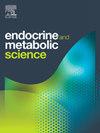奥利司他与白藜芦醇复合减肥药对肥胖的影响:多中心随机对照研究(EC-FIT)
Q3 Medicine
引用次数: 0
摘要
背景:由于不遵守饮食和运动建议,减肥药利司他的效果往往较差。然而,它的有效性往往受到不遵守建议的生活方式改变和脂肪漏等副作用的影响。奥利司他与白藜芦醇联合使用可以促进体重减轻,并提供额外的代谢益处。目的本研究评估奥利司他联合白藜芦醇与奥利司他单用在缅甸超重或肥胖人群中的实际疗效和安全性。方法将BMI≥25 kg/m2的成年人随机分为两组,进行为期12周的研究。奥利司他(O)组给予奥利司他120 mg,每日3次;白藜芦醇(O-R)组口服奥利司他120 mg +白藜芦醇100 mg,每日3次。测量的主要结局是体重变化;次要结局包括总胆固醇、低密度脂蛋白胆固醇、血压、糖化血红蛋白、谷丙转氨酶(ALT)、控制衰减参数(CAP)、肝脏僵硬度和体脂总量。不良事件也有记录。结果O-R组体重减轻较多(- 3.31 kg, 95% CI: 2.36-5.04, p <;0.001)比0组(- 2.92 kg, 95% CI: - 2.6442-4.5471, p <;0.001)。此外,O-R组总体脂肪(- 4.93%)、舒张压(78.38 mmHg vs 75.93 mmHg;95% CI: 0.4473-4.4707, p <;0.05), CAP评分(276.62 dB/m vs 253.16 dB/m;95% CI: 8.46-38.85, p <;0.05)。O-R组在伴有脂肪变性(S1-S3)或纤维化(F2-F4)的肥胖患者和糖尿病患者中观察到显著的体重减轻,特别是BMI≥30的患者(- 2.79 kg vs - 1.04 kg, p <;0.05)和脂肪变性(- 2.17 kg vs - 0.44 kg, p <;0.05)。两组均出现脂肪溢,而仅O组出现腹泻。结论在奥利司他的基础上添加白藜芦醇对减肥有协同作用,在降低体脂和舒张压方面有额外的益处。这些益处在患有肥胖或脂肪变性的糖尿病患者亚组中也很明显。试验注册号:ISRCTN10642495。本文章由计算机程序翻译,如有差异,请以英文原文为准。
Effects of a novel weight-loss combination product containing orlistat and resveratrol on obesity: A multicenter randomized controlled study (EC-FIT)
Background
Orlistat, a weight loss medication, is often less effective due to poor adherence to the dietary and exercise recommendations. However, its effectiveness is often compromised by poor adherence to recommended lifestyle changes and side effects like steatorrhea. Combining orlistat with resveratrol may enhance weight loss and offer additional metabolic benefits.
Objective
This study evaluated the real-world efficacy and safety of orlistat combined with resveratrol versus orlistat alone in overweight or obese individuals in Myanmar.
Method
Obese adults (BMI ≥ 25 kg/m2) were randomized into two groups for a 12-week study. The Orlistat (O) group received orlistat 120 mg three times daily, while the Orlistat & Resveratrol (O-R) group took orlistat 120 mg plus resveratrol 100 mg thrice daily. Primary outcome measured was weight change; secondary outcomes included Total Cholesterol, LDL-cholesterol, Blood pressure, HbA1c, alanine transaminase (ALT), controlled attenuation parameter (CAP), Liver stiffness, and Total Body Fat. Adverse events were also recorded.
Result
The O-R group lost more weight (−3.31 kg, 95 % CI: 2.36–5.04, p < 0.001) than the O group (−2.92 kg, 95 % CI: −2.6442–4.5471, p < 0.001). Additionally, the O-R group showed greater reductions in total body fat (−4.93 %), diastolic blood pressure (78.38 mmHg vs 75.93 mmHg; 95 % CI: 0.4473–4.4707, p < 0.05), and CAP score (276.62 dB/m vs 253.16 dB/m; 95 % CI: 8.46–38.85, p < 0.05). Significant weight loss in the O-R group was observed in obese patients with steatosis (S1–S3) or fibrosis (F2–F4), and in diabetic patients, particularly those with a BMI ≥30 (−2.79 kg vs −1.04 kg, p < 0.05) and steatosis (−2.17 kg vs −0.44 kg, p < 0.05). Steatorrhea occurred in both groups, while diarrhoea was noted only in the O group.
Conclusion
Addition of resveratrol to orlistat provides synergistic benefits to weight loss with additional benefit in terms of reducing total body fat and diastolic BP. These benefits were also apparent in subgroup of patients with diabetes suffering from obesity or steatosis.
Trial registration number: ISRCTN10642495.
求助全文
通过发布文献求助,成功后即可免费获取论文全文。
去求助
来源期刊

Endocrine and Metabolic Science
Medicine-Endocrinology, Diabetes and Metabolism
CiteScore
2.80
自引率
0.00%
发文量
4
审稿时长
84 days
 求助内容:
求助内容: 应助结果提醒方式:
应助结果提醒方式:


